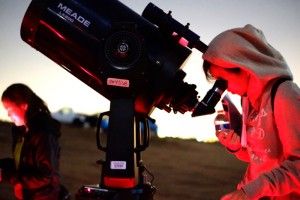The UC Irvine Observatory played host to ASUCI’s event “A Night with the Stars” on Tuesday Oct. 15 with the help of ASUCI’s Academic Engagement Commission and the School of Physical Sciences.
Sitting on top of an enormous mound of earth in a desolate area near Vista Del Campo, the observatory looks out over much of UCI.With dozens of students walking around with sky maps in hand and lining up outside the dome to either catch a glimpse of the universe or to enjoy the complimentary popcorn, donuts and drinks, the turnout was a pleasant surprise, according to Kevin Trinh.

“We didn’t expect this many students to come out,” said Trinh, a third-year biological sciences major and assistant commissioner of academic engagement. “So this is pretty amazing, our main goal was to provide students with the opportunity to develop a stronger faculty and student connection while also learning about the galaxy and socializing with their friends.”
Mei Liang, a fourth-year pharmaceutical sciences major and assistant commissioner, also provided an inside look into the preparations to make sure this event went smoothly: “It was a big planning process between ASUCI’s Academic Engagement Commission and the Department of Astronomy within the School of Physical Sciences,” Mei explained. “We planned it a month or two in advance and worked with some grad students as well.”
Faculty members were also present to oversee the special occasion and even lecture, including the professor and dean of Physical Sciences, Kenneth Janda, as well as professor Tammy Ann Smecker-Hane of astrophysics and cosmology. The night commenced with an opening message from Dean Janda, welcoming the students, followed by an informative lecture by professor Smecker-Hane as she described the main components of the observatory and the ways in which they are utilized.
“The observatory is home to four telescopes: The primary one is 24 inches and is placed within the dome itself and three portable telescopes. These can be used to observe the Ring Nebula, Uranus and much more,” Smecker-Hane said.
Following the presentation, students were free to look through the main telescope in the dome or roam around the area, trying to decipher constellations courtesy of the evening sky maps that were distributed earlier. Experienced students walking around and offering assistance for those who needed it. Informational fliers and pamphlets were readily available as well, with interesting tips about how to observe the night sky, celestial bodies, and even a helpful astronomical glossary.
With visitor nights being held a total of six times during the course of the upcoming year, the next one on Nov. 9th, anyone can come to witness a meteor shower, solar and lunar eclipse, or just simply to stargaze.




